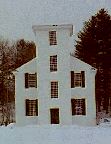Trinity Church |
|
|
Site: N08-2
|
National Register Nomination Information:
DESCRIPTION: Trinity is an interesting example of a New England village church. Constructed of wood, it is typically unsophisticated, unpretentious and even stark in its simplicity. It is nevertheless picturesque and beautiful in its rural setting. The building was originally constructed in 1808 from a plan drafted by Philip Tabor, a carpenter and builder. Early records describe it as "36 feet by 44 feet with two porches and a belfry with a steeple and of suitable height." Most of the elements of the original building remain intact. The king post trusses with their hand-hewn members and mortise-and-tenon joints are in excellent condition, bearing testimony to the skill of the early craftsmen. Weathered clapboards, split-board lath, small-paned windows, and wide-paneled pine pews are among the features which appear to date back to the building's origin. Alterations have been made over the years as an inspection of the building will reveal. A balcony which once surrounded three sides of the interior was removed, although evidence of it remains. One of the original "proches" was removed and replaced by a semi-circular chancel, which also has been removed. The lofty ceiling was replaced by a lower one, but the original is still visible. In general, the building is in sound condition. It offers an unusually good opportunity to observe the workmanship of the New England builder who employed native materials and used ornament sparingly; and to appreciate the engineering skill of the country craftsman. It is a fine example of native, creative engineering and art.
The history of Trinity Church has special significance inasmuch as it is part of the history of the township of Cornish. Dudley Chase was one of three men who in 1765 came up the Connecticut River in a canoe to establish the first settlement in Cornish. His son, Philander, a student at Dartmouth College, was so impressed with the Book of Common Prayer that he induced his relatives and friends to establish an Episcopal Society in Cornish in 1793. From this grew Trinity Church which was incorporated in 1795. Philander Chase became Bishop of the Diocese of Ohio and was the founder of Kenyon College. Other prominent members of the Chase family were Jonathan Chase, an officer who served with distinction in the Revolutionary War; and Salmon Portland Chase, a Chief Justice of the United States Supreme Court. Trinity Church is closely tied to the history of Cornish and of the Chase family, which played a prominent role in both local and national affairs. Trinity Church is located in that part of Cornish which became known as the "Cornish Colony," or "Little New York" in the late 19th century. Here a number of prominent figures in literature and the arts spent their summers. The Saint-Gaudens National Historic Site, administered by the National Park Service, memorializes the sculptor, Augustus Saint-Gaudens; it is located within a mile of Trinity Church. The association of the church with the Colony gives the building further significance.
Child, William H. History of the Town of Cornish,New Hampshire 1763-1910. (Concord: Rumford Press, 1910 [other source says 1911]. Two Volumes. Farmer, James and Jacob Moore. Gazetteer of New Hampshire. 1823. Rawson, Barbara. History of Cornish New Hampshire, 1910-1960. 1960. Speare, Eva. Colonial Meeting Houses of New Hampshire. 1939, rev. 1955. Sinnott, Edmund W., Meetinghouse and Church in Early New England, (NY:McGraw-Hill, 1963)
DATE ENTERED: July 31, 1978.
|
BACK TO NATIONAL REGISTER PROPERTIES
